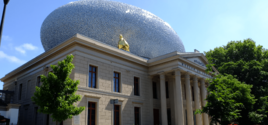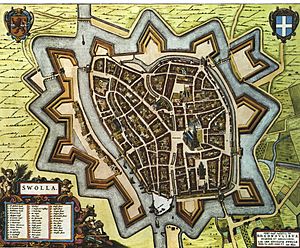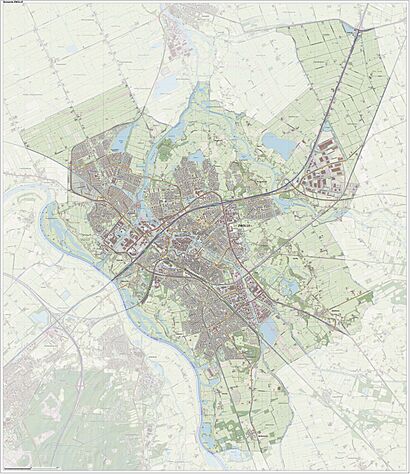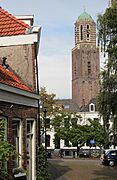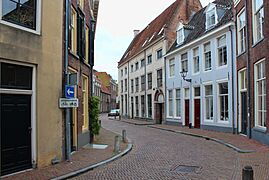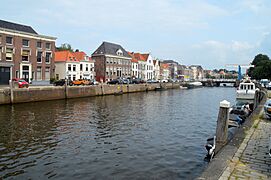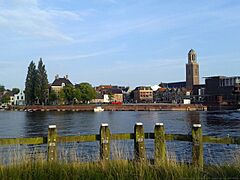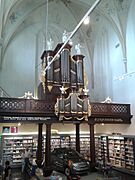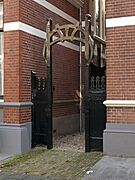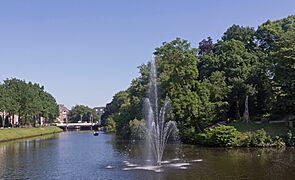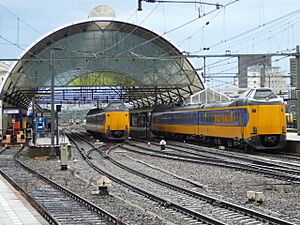Zwolle facts for kids
Quick facts for kids
Zwolle
|
|||||
|---|---|---|---|---|---|
|
City and municipality
|
|||||
|
Sassenstraat
Grote Markt
Museum de Fundatie
Luttekestraat
Binnenstad
|
|||||
|
|||||
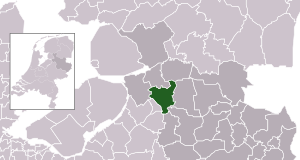
Location in Overijssel
|
|||||
| Country | Netherlands | ||||
| Province | Overijssel | ||||
| Government | |||||
| • Body | Municipal council | ||||
| Area | |||||
| • Municipality | 119.36 km2 (46.09 sq mi) | ||||
| • Land | 111.38 km2 (43.00 sq mi) | ||||
| • Water | 7.98 km2 (3.08 sq mi) | ||||
| Elevation | 4 m (13 ft) | ||||
| Population
(Municipality, May 2014; Urban and Metro, May 2014)
|
|||||
| • Municipality | 123,507 | ||||
| • Density | 1,109/km2 (2,870/sq mi) | ||||
| • Urban | 123,507 | ||||
| • Metro | 181,440 | ||||
| Demonym(s) | Zwollenaar | ||||
| Time zone | UTC+1 (CET) | ||||
| • Summer (DST) | UTC+2 (CEST) | ||||
| Postcode |
8000–8049
|
||||
| Area code | 038 | ||||
| Click on the map for a fullscreen view | |||||
Zwolle (pronounced ZWO-luh) is a cool city and a municipality in the northeastern part of the Netherlands. It's the capital of the province of Overijssel. Zwolle is the second-largest city in Overijssel, right after Enschede. As of December 2023, about 132,441 people live there. The city is located near the province of Gelderland and sits on the eastern side of the IJssel River.
Contents
A Look into Zwolle's Past
Did you know people have lived around Zwolle for a very long time? Archaeologists found a woodhenge (an ancient wooden circle) in 1993. It was built way back in the Bronze Age! Later, during the Roman times, a group called the Salian Franks lived here.
How Zwolle Began
The city we know today was started around the year 800 CE. Frisian traders and soldiers from Charlemagne's army helped build it. The name Zwolle comes from an older word, Suolle, which means "hill." This makes sense because Zwolle was built on a small hill. This hill was important because it stayed dry when the nearby rivers (the IJssel, Vecht, Aa, and Zwarte Water) often flooded.
Important Buildings and Events
One of the oldest buildings is the St. Michael's Church (Grote of Sint Michaëlskerk). It was first mentioned in old documents and was rebuilt in the 1400s. You can still see it today! Inside, it has an amazing pulpit and a beautiful Baroque organ from 1721.
On August 31, 1230, Zwolle was given "city rights" by the bishop of Utrecht. This meant it could govern itself more. In 1294, Zwolle joined the Hanseatic league. This was a powerful group of trading cities in Northern Europe. Zwolle became very rich in the 1400s. Its economy grew six times bigger between 1402 and 1450!
Sadly, Zwolle also faced tough times. In 1324 and 1361, local noblemen set the city on fire. In the 1324 fire, only nine buildings were left standing!
The Brethren and Thomas à Kempis
Zwolle was also a center for a religious group called the Brethren of the Common Life. About 5 kilometers from Zwolle, on a hill called Agnietenberg, there was a monastery. A famous writer named Thomas à Kempis lived and died there in 1471. He wrote a very important book called The Imitation of Christ.
Zwolle in Modern Times
By the early 1900s, Zwolle was a busy trading city. It had a big fish market and one of the most important cattle markets in the Netherlands. Industries like cotton, iron, boat-building, and rope-making were also important.
During World War II, a brave French-Canadian soldier named Léo Major single-handedly freed Zwolle from the Germans. He was made an honorary citizen of Zwolle in 2005. There's even a street named after him, Leo Majorlaan!
Zwolle's Famous Restaurant
In 2004, Zwolle's restaurant, De Librije, received 3 stars from the Michelin Guide. This is a huge honor for a restaurant! As of 2018, it was one of only three restaurants in the entire country with this many stars.
Why are Zwolle Citizens Called 'Bluefingers'?
Citizens of Zwolle are often called Blauwvingers (Bluefingers). There's a fun story about this! In 1682, the St. Michael's church tower fell down. The city needed money to fix it, so they sold the church bells to the nearby city of Kampen. Zwolle asked for a high price. Kampen agreed, but when the bells arrived, they were too broken to be used.
To get back at Zwolle, Kampen paid for the bells using lots of tiny copper coins. Zwolle's people had to count all these coins very carefully. They counted so much that their fingers turned blue from the copper!
However, the real story is a bit different. The name Blauwvinger actually comes from 1521. At that time, the leaders of Zwolle broke their promise of loyalty to the Duke of Gelre. They had raised their fingers to swear loyalty. Zwolle and Kampen were fighting over tolls on the IJssel River. Zwolle first sided with the Duke but later went back to the Bishop of Utrecht. During this time, the Duke was even captured in Zwolle! The name "Bluefingers" refers to the fact that the residents broke their promises twice.
Exploring Zwolle's Geography and Landmarks
Zwolle has many cool historic buildings besides the St. Michael's Church.
Famous Buildings and Museums
- The Roman Catholic Onze Lieve Vrouwe ten Hemelopneming (Our Lady of the Assumption) basilica was built in 1399. Its church tower, called Peperbus (which means "pepperpot"), is one of the tallest and most famous church towers in the Netherlands.
- The modern town hall was originally built in 1448.
- You can also see the Sassenpoort (one of the old city gates) and parts of the old city walls.
- The Mosterdmakerstoren (mustard makers' tower) is where local mustard used to be made.
- There's a guild-house from 1571 and a former Dominican monastery.
- On Melkmarkt, you'll find two museums: the Stedelijk Museum Zwolle (for old things and nature) and the Vrouwenhuis.
- Museum de Fundatie, the main art museum for the Overijssel province, is in the old Justice Hall.
Art Nouveau Architecture
In the western part of the city, near the railway station, there's a neighborhood with beautiful Art Nouveau buildings. These unique houses were built around the 1900s. Many of them, especially on Koningin Wilhelminastraat, Prinses Julianastraat, and Prins Hendrikstraat, are protected by the Dutch government because they are so special.
The Broerenkerk Church
The Broerenkerk church was once part of a Dominican monastery started in 1465. The monastery closed in 1580. From 1640 until 1982, the church was used for Protestant services. After being fixed up, it's now used for cultural events and is even a bookstore!
Images for kids
-
Herman Brood Museum & Experience
Famous People from Zwolle
Many interesting people have come from Zwolle!
- Artists and Performers:
* Gerard ter Borch (1617–1681), a famous painter. * Herman Brood (1946–2001), a painter and rock star. * Tooske Breugem (born 1974), a television host and actress. * Ton Koopman (born 1944), a conductor and organist. * Charlotte Wessels (born 1987), a singer.
- Writers:
* Rhijnvis Feith (1753–1824), an author.
- Religious Figures:
* Thomas à Kempis (about 1380–1471), a monk and mystic.
Learning in Zwolle
Zwolle is a great place for education! It has several universities and colleges, including:
- Artez
- Christelijke Hogeschool Windesheim
- Deltion College Zwolle
- Landstede Zwolle
- Windesheim Honours College
Getting Around Zwolle
Zwolle is an important center for travel in the Netherlands.
Roads and Highways
Zwolle is a key point in the country's highway system. The A28 highway goes through Zwolle, connecting Utrecht to Groningen. Another highway, the A50, meets the A28 near Zwolle. This road helps traffic go south towards Apeldoorn and Eindhoven. Other important roads also start from Zwolle, connecting it to other cities.
Bridges in Zwolle
Because Zwolle is surrounded by rivers, it has many important bridges. The main one is the IJssel Bridge, where the A28 motorway crosses the IJssel River. It was built in 1970 and is used by over 125,000 vehicles every day! There's also an older IJssel Bridge from 1930. A third bridge, called the Hanze boog, carries railway lines. There are also several bridges over the Zwarte Water and Vecht rivers.
Train Travel
The first train arrived in Zwolle on June 6, 1864. Today, Zwolle is a major railway hub. You can catch a train from Zwolle in eight different directions! A new train line, the Hanzelijn, opened in December 2012. It connects Zwolle to Lelystad and Amsterdam. A second train station, Zwolle Stadshagen, opened in 2019.
Waterways
Zwolle is located near three rivers: the Zwarte Water, Vecht, and IJssel. It also has several canals. Some industries in Zwolle use these waterways for their business.
Zwolle's International Connections
Zwolle has special connections with other cities around the world.
Sister Cities
Currently, Zwolle is a "twin town" with:
 Lünen, Germany
Lünen, Germany
In the past, Zwolle also had partnerships with cities like:
 Érsekhalma, Hungary
Érsekhalma, Hungary Rutobwe, Rwanda
Rutobwe, Rwanda Vologda, Russia
Vologda, Russia Kaliningrad, Russia
Kaliningrad, Russia
There's even a small town in the U.S. state of Louisiana called Zwolle. The two places have friendly informal ties!
See also
 In Spanish: Zwolle para niños
In Spanish: Zwolle para niños




